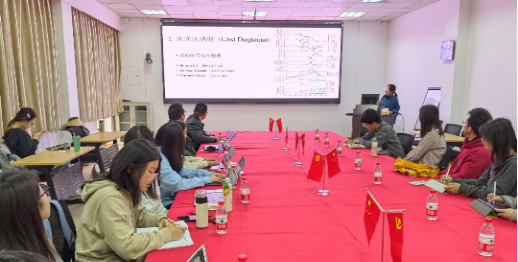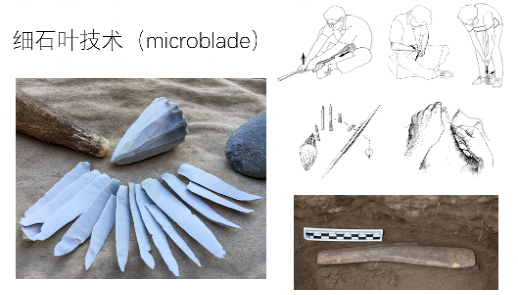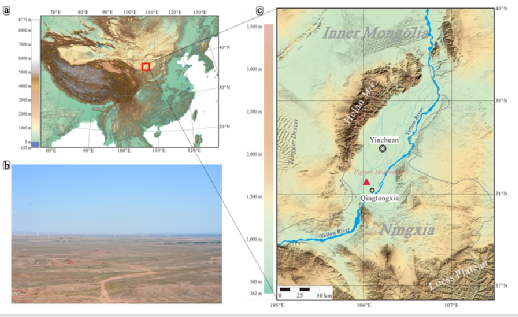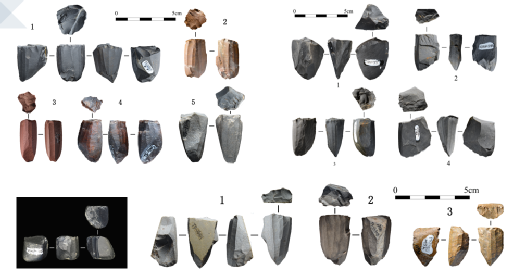Technical Adaptations of Hunter-Gatherers in Northwest China Since the Last Deglaciation & Lecture Newsletter

Title: Technical Adaptation of Hunter-Gatherers in Northwest China Since the Last Glacial Termination
Speaker: Dr. Han Fang (Center for Archaeological Science, Sichuan University)
Discussant: Zheng Zhexuan (Director of the Institute of Paleolithic Archaeology, Sichuan Provincial Institute of Cultural Relics and Archaeology)
About the Speaker:
Han Fang is currently an assistant researcher at the Center for Archaeological Science, Sichuan University. Her research focuses on Paleolithic archaeology, with an emphasis on the spread of lithic technology and population dispersal during the Late Paleolithic, research theories of hunter-gatherers, and human behavioral adaptation in extreme environments. She has published several papers in journals such as Archaeology, Acta Anthropologica Sinica, and Archaeological and Anthropological Sciences, and has published a monograph (co-authored). She also presides over research projects such as the National Natural Science Foundation of China Youth Project and postdoctoral funds.
Time: March 15, 2024, 15:30-17:30
Location: Conference Room on the First Floor of the Red Tile Building, Tibetan Studies Institute, Wangjiang Campus, Sichuan University
Lecture Communication
On the afternoon of March 15, 2024, the 13th session of the "Archaeological Science Forum" hosted by the Center for Archaeological Science, Sichuan University, was successfully held in the conference room of the China Tibetan Studies Institute, Wangjiang Campus, Sichuan University. Han Fang, an assistant researcher at the Center for Archaeological Science, Sichuan University, gave a lecture on "Technical Adaptation of Hunter-Gatherers in Northwest China Since the Last Glacial Termination." Zheng Zhexuan, Director of the Institute of Paleolithic Archaeology, Sichuan Provincial Institute of Cultural Relics and Archaeology, commented, and Yuan Haibing, an associate professor at the Center for Archaeological Science, Sichuan University, presided over the session.

At the beginning of the forum, the speaker introduced the basic theoretical background of the technical adaptation of hunter-gatherers in Northwest China since the Last Glacial Termination. The Last Glacial Termination is the period of transition of the Earth's climate from the Last Glacial Maximum to the Holocene. The climate fluctuated significantly during this stage, mainly reflected in several major climatic events, such as the relatively cold Heinrich 1 event, the B酶lling-Aller酶d interstadial, and the Younger Dryas event. Against the background of rapid climate change, archaeological discoveries in China also show corresponding changes. For example, ground stone tools and pottery appeared almost simultaneously in the north and south, as reflected in the Xiaonanshan site in Raohe, Heilongjiang, the Xianrendong site in Wannian, Jiangxi, and the Yuchanyan site in Daoxian, Hunan. However, in the arid regions of Northwest China, these new archaeological cultural elements are relatively rare due to the relatively harsh environmental conditions.
Microblade technology is considered to be the pinnacle of Paleolithic lithic technology development since the Last Glacial Period. Since the Last Glacial Termination, the distribution range of microblade remains has expanded unprecedentedly, and remains of microblade populations have been found in the Qinghai-Tibet Plateau and other places. Microblade production mainly uses pressure flaking technology and indirect percussion technology, focusing on the preform of the core. Microblade tools are easy to carry, can be continuously replaced and used as composite tools, and can continuously produce usable edges with a high degree of standardization. They have significant practical significance for the highly mobile production and life of hunter-gatherers.

Schematic diagram of microblade technology and its products
From the perspective of East Asia, the microblade technology system roughly includes two types. The first type is the "Yubetsu system" technique, which mainly uses bifacial tool processing blanks. This technology is divided into many technical subtypes through different organization modes of the platform surface and the flaking surface. Remains of this technology have been found in northern China (such as the Nihewan Basin and Northeast China), the Japanese archipelago, the Korean Peninsula, the Russian Far East, and even northwestern North America. The second type is the "non-Yubetsu system" technique, represented by conical cores, semi-conical cores, and wedge-shaped cores using flakes as blanks. Compared with the "Yubetsu system", the preform degree of microcores is relatively low, and its production concept may be related to flake production. This technical system has been found in many areas such as Shanxi and Shaanxi in northern China, and its age can be traced back to about 28,000 years ago.
The Gezishan site is located in Qingtongxia City, Ningxia Hui Autonomous Region, in the southeastern part of the Helan Mountains. The site is located at the junction of temperate grassland and desert, surrounded by desert, with little annual precipitation and a dry climate. The site was discovered in the 1980s, and trial excavations were carried out in the 1990s and 2013, respectively. From 2014 to 2017, the Institute of Vertebrate Paleontology and Paleoanthropology of the Chinese Academy of Sciences, the Ningxia Institute of Cultural Relics and Archaeology, and other units jointly excavated Location 10, which has good deposits and abundant relics.

Schematic diagram of the location of the Gezishan site
Location 10 mainly contains three cultural layers, and relics such as post holes and hearths have been found. In addition to stone products, ostrich eggshell ornaments and other relics have also been found. The types of stone products mainly include simple cores-flakes and microblade products. The tool types are mainly scrapers, bifaces, and pointed tools. Processing tools such as grinding discs and grinding rods have also been found. The age of the main cultural remains at Location 10 is 14,000-11,000 years ago.
In terms of stone material selection, the Gezishan site mainly reflects two types: local and foreign. The former mainly includes products made of quartzite, siliceous fine sandstone, and hornfels scattered on the surface, while the latter mainly includes various flints and agates. Statistical results show that the Gezishan people have a certain tendency in the selection of stone materials. Core-flake products are mostly produced from local stone materials, while microblades mainly use flint, agate, and higher-quality hornfels. Small tools mostly use flint and agate. At the same time, combining the core steering situation, renewal flakes, and the comparison between the length of microblades and microcores, the cores or microcores produced from the two stone material sources all show a phenomenon of strengthened utilization.
In terms of technical strategies, as far as simple core-flake technology is concerned, the cores found at the site are mainly pebbles with stone skin surfaces, and no preform flakes and core platforms have been found. The flaking surface organization presents a variety of organization forms. As far as microblade technology is concerned, conical cores, wedge-shaped cores with flakes as blanks, semi-conical cores, and irregular cores have been found. Technical analysis shows that the Paleolithic humans at this stage invested less in microcore preforming and focused on maintaining the flaking surface.

Gezishan site microcores
Combining the analysis of core-flake technology and microblade technology, the Gezishan site has two technical organization strategies: "delicacy" and "expediency". The stone material utilization mode reflects a strengthened utilization trend characterized by reuse and secondary processing. When regional stone materials are abundant, the trend of strengthened utilization of stone materials at the site indicates the relationship between the environment, site utilization, and lithic technology strategies of Paleolithic humans during this period. The period in which the Gezishan site is located was a period when springs were active in the area, and regional resources were concentrated. Combining the site's relics and remains, it is speculated that the site was a central camp for Paleolithic humans, and at the same time shows the low camp movement strategy of Paleolithic humans in the area.
In terms of the utilization of animal and plant resources, the site seems to show the "broad spectrum revolution" event that widely occurred globally during the Last Glacial Termination. Through animal remains analysis, we can see the strengthened utilization of animal resources by Paleolithic humans. Plant archaeology and stone tool residue analysis both show that Paleolithic humans used a variety of plant species and used them in a variety of ways, including food, construction, and firewood.
Finally, the speaker summarized the Paleolithic human survival information presented by the Gezishan site. The study of the Gezishan site reveals the camp construction, lithic production, and gathering and hunting activities of Paleolithic humans in the desert marginal area against the background of this fluctuating climate transition period of the Last Glacial Termination. Different technical strategies reflect the different activity needs of the population at the site, and the strengthened utilization of stone materials and animal and plant resources shows the adaptation of Paleolithic humans to the distribution of resources in the region.
Zheng Zhexuan, Director of the Institute of Paleolithic Archaeology, Sichuan Provincial Institute of Cultural Relics and Archaeology, affirmed the research value of the Gezishan site in his comments. Among the sites of the Last Glacial Termination stage currently discovered in China, the Gezishan site is located on the edge of the desert and the edge of the Qinghai-Tibet Plateau, and is an interactive area of several resource areas. Since the Last Glacial Termination, with the increase in population, the amount of per capita resources has decreased, forcing humans to further think about the utilization of tools, prompting further improvement of the physical and cognitive level of Paleolithic humans, and the site information also presents a more complex resource utilization situation. Lithic technology is the most important technology in the production and life of Paleolithic populations. Studying different aspects of the lithic technology of the Gezishan site can help understand the ecological adaptation strategies of the hunter-gatherer population at the site from the perspective of lithic products. Associate Professor Yuan Haibing summarized, pointing out that the research on the Gezishan site fully reflects the goal of "seeing the big in the small" in archaeological research. The seemingly inconspicuous lithic technology actually contains important codes for understanding the technical adaptation of hunter-gatherer populations since the Last Glacial Termination. At the same time, Professor Yuan also encouraged everyone to actively participate in archaeological work, from the Paleolithic Age to the historical period, and carry out archaeological research with an international perspective. Subsequently, teachers and students present discussed issues such as the utilization of spring water at the site, the source of stone materials in the desert environment, and the relationship between microblade technology mobility and site utilization time.
